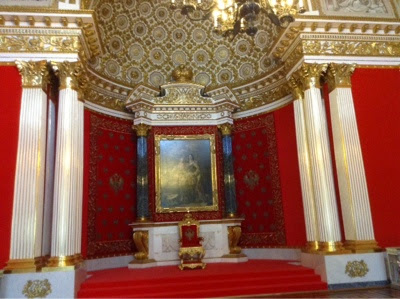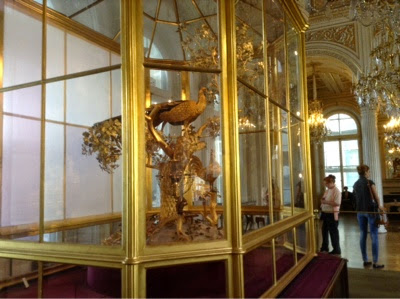The Hermitage (Winter Palace) and Museum. As seen from across the river at Maritime Square.
One of the largest and oldest museums in the world, it was founded in 1764 by Catherine the Great
and has been open to the public since 1852. Its collections, of which only a small part is on permanent display, comprise over three million items.
EntryInlay floor matches ceiling design
The Peacock Clock is large automaton featuring three life-sized mechanical birds. It was manufactured by the entrepreneur James Cox in the 2nd half of the 18th century and through the influence of Grigory Potemkin it was acquired by Catherine the Great in 1781.
Mozaic floor
The Nativity - Giovanni della Robbia 1469-1529
The Lute Player - Caravaggio
In 1991, it became known that some paintings looted by the Red Army in Germany in 1945 were held in the Hermitage. In October 1994 the Hermitage officially announced that it had secretly been holding a major trove of French Impressionist and Post-Impressionist paintings from German private collections. The exhibition "Hidden Treasures Revealed", where 74 of the paintings were displayed for the first time, was opened on 30 March 1995, in the Nicholas Hall of the Winter Palace and lasted a year. Of the paintings, all but one originated from private rather than state German collections, including 56 paintings from the Otto Krebs collection, as well as the collection of Bernhard Koehler and paintings previously belonging to Otto Gerstenberg and his daughter Margarete Scharf, including world-famous Place de la Concorde by Degas, In the Garden by Renoir, White House at Night by Van Gogh, and some other collections. Some of the paintings are now on permanent display in several small rooms in the northeastern corner of the Winter Palace on the first floor.
Morning Going Out to Work - Vincent van Gogh
The Dancer - Edgar Degas
The Seine at Asnieres - Claude Monet
We left the museum after this and walked through the Hermitage garden to the St. Petersburg Square. "Palace Square is the central square of St. Petersberg, which conjoins some of the city’s major landmarks and monuments, including most famously the Winter Palace. Because it is so spacious it regularly functions as the grounds for national parades, bards, and concerts. In the past, tthe square has been transformed during the winter months to become a free ice rink.
Palace square was also the setting for some of Russia’s most significant historical events including the Bolshevik Revolution of 1917 and the 1905 massacre Bloody Sunday, where peaceful protesters were gunned down while trying to present Tsar Nicholas II with a petition".
Palace square was also the setting for some of Russia’s most significant historical events including the Bolshevik Revolution of 1917 and the 1905 massacre Bloody Sunday, where peaceful protesters were gunned down while trying to present Tsar Nicholas II with a petition".
We sailed fo Helsinki and home.















































1 comment:
Sharon, I love reading your and Terry's blogs. It gives me a glimpse into places we may have/need to visit. So far Amsterdam is a must but I have to admit Russia has not made the list.
Post a Comment